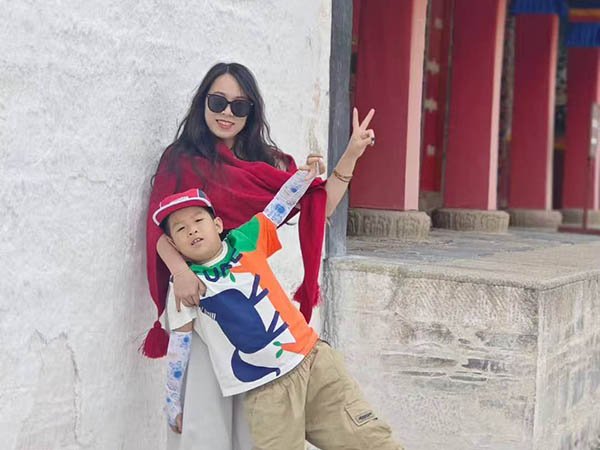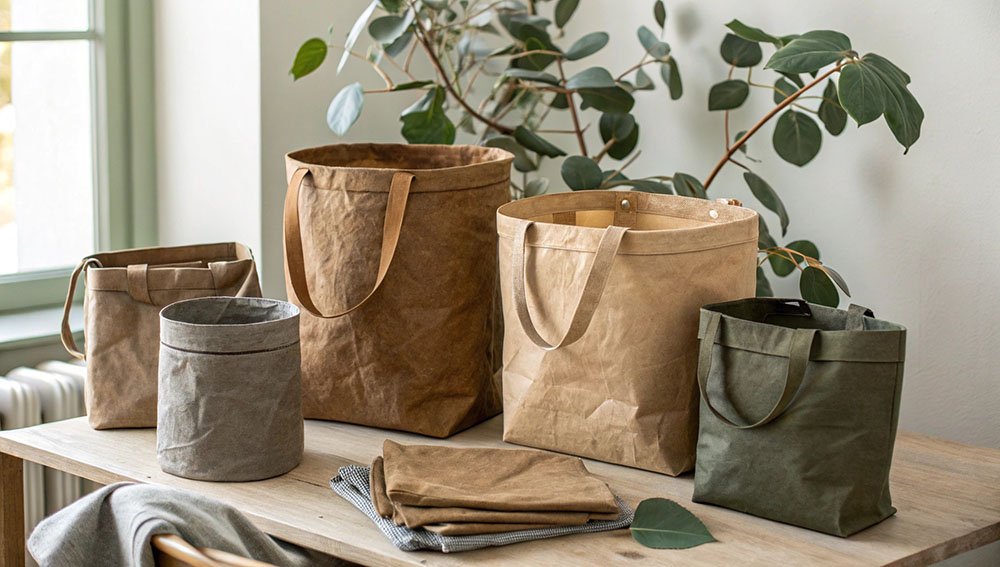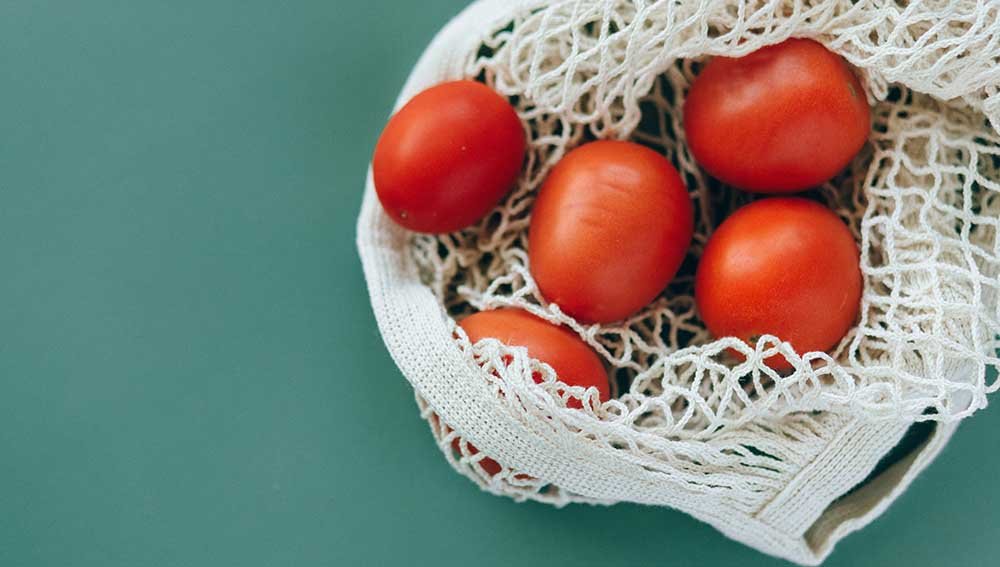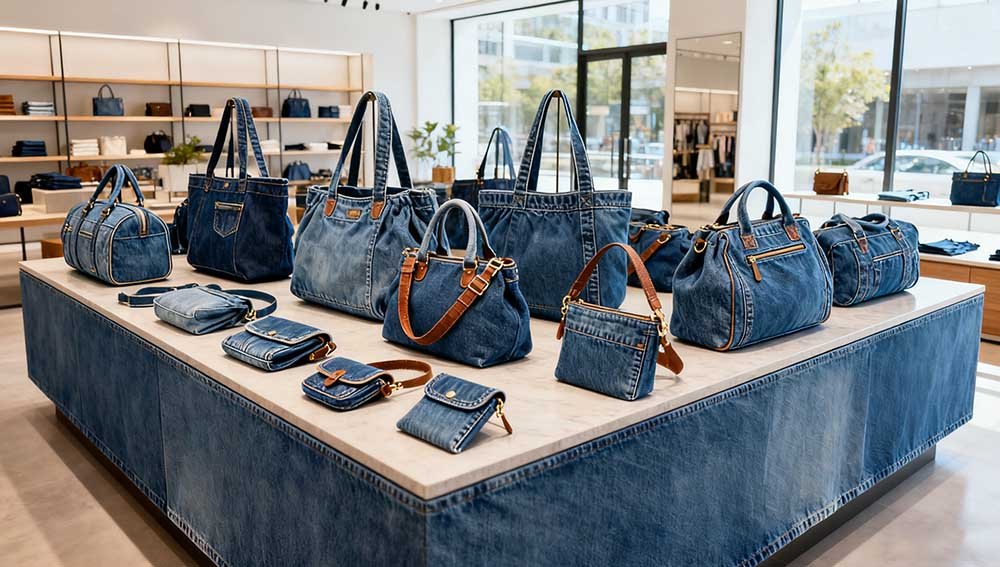Are you confused by all the numbers when choosing a custom bag? You need a bag that lasts. But how do you pick the right fabric thickness?
Polyester fabric thickness is key. It determines the bag’s strength and feel. You look at Denier (D) or GSM. Higher numbers mean thicker, stronger fabric. Choose a high number for heavy items. Choose a lower number for a light, foldable bag.
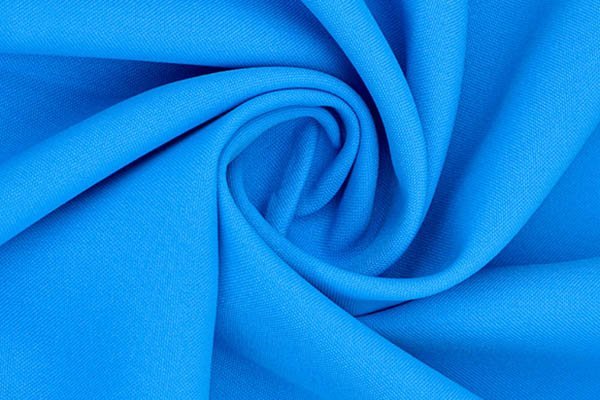
Picking the right thickness is a big decision. It affects cost and how people use the bag. You want a bag that works well for its job. Let us look at what those numbers mean for your custom bag project.
What Does Polyester Fabric Thickness Really Mean?
You see terms like "Denier" and "GSM." What do these terms mean for your final product? How do they tell you the fabric’s real thickness?
Polyester thickness is measured by GSM (Grams per Square Meter) or Denier (D). Denier tells you the weight of the thread. A higher D number means a thicker thread. This makes the fabric stronger. GSM is the weight of the whole fabric piece. Both affect the bag’s feel, durability, and how much weight it can carry.
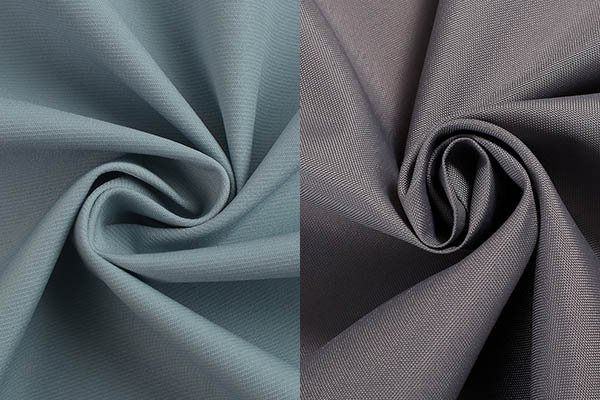
It is important to understand Denier1 et GSM2. They are the language of fabric quality. The thickness has a direct impact on the bag. A thick fabric feels more expensive. It will wear out slower. A thinner fabric is easy to carry. Knowing these terms helps you make a better choice.
Decoding Fabric Weight: GSM and Denier
Thickness is more than just a visual measure. It is a technical specification. GSM, or Grams per Square Meter, shows the fabric’s density. A 100 GSM fabric is lightweight. A 400 GSM fabric is heavy-duty. This value includes the weight of the fibers and any coatings. Denier (D), however, focuses on the individual yarn. Denier is the weight in grams of 9,000 meters of a single thread. For example, 600D polyester yarn weighs 600 grams per 9,000 meters. Higher D means a thicker yarn. Thicker yarns create a tougher weave. This tougher weave makes the fabric more resistant to abrasion. This is why D is a better measure for a bag’s strength and durability. When you choose a custom bag, you must ask for the Denier. It tells you the true story of the bag’s potential lifespan and how much the bag can actually hold. This technical detail helps your business ensure quality.
| Measurement | Focus | Impact on Bag | Example Range |
|---|---|---|---|
| Denier (D) | Weight of the thread | Strength, Durability, Feel | 190D to 600D+ |
| GSM | Weight of the fabric piece | Overall Thickness, Weight, Cost | 70 GSM to 300 GSM |
| T (Thread Count) | Number of threads (for thin fabric) | Foldability, Lightness | 190T to 210T |
Why Does Bag Thickness Matter for Durability and Function?
You do not want a bag that breaks on the first use. So, why should you care deeply about the thickness of your polyester bag?
The bag’s thickness is a matter of function. It decides how long your bag will last. A thin bag is good for small, light items. It is easy to fold. A thick bag can hold heavy groceries or travel gear. It is much stronger. Matching the thickness to the use is the best way to ensure durability.
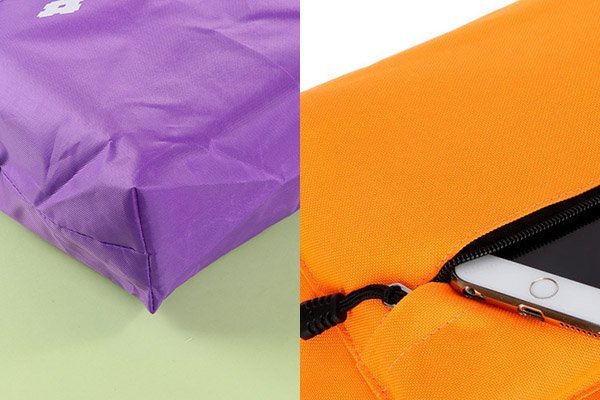
Thickness is not just about strength. It is about the bag’s whole life. A durable bag is a good investment. It promotes your brand longer. If the bag breaks quickly, it hurts your brand image. A properly thick bag serves its purpose well. It is a sign of a quality product.
The Mechanics of Load Bearing and Tear Resistance
Thickness is the key factor in a bag’s ability to bear weight. Thicker fibers and a tighter weave structure reduce stress points. When you put heavy items into a bag, a low-D fabric is more likely to stretch and tear at the seams. A high-D fabric distributes the weight better. For a brand, the bag’s lifespan is important. A bag that lasts for years is a constant advertisement for your company. This is especially true for items like promotional totes or conference bags. You want the bag to be functional long after the event ends. This long life creates better brand recall. For products designed for frequent use, such as book bags or grocery carriers, choosing at least a 300D fabric ensures the material resists daily wear and tear. This higher durability prevents early failure.
Portability Versus Structure
The bag’s intended function guides the thickness choice. If a bag is designed to be a portable, compact shopping aid, then thinness is the goal. For example, a 190T bag can fold up to fit in a pocket. This high level of convenience is its main value. However, if the bag’s job is to carry heavy, irregular items or maintain a specific shape, structure is necessary. A thicker material, like 600D, is stiffer. It gives the bag a rigid form. This structure is essential for items like laptop bags or tool carriers. Thin bags are good for light gifts or emergency shopping. Thick bags are better for daily, heavy-duty needs. This simple choice defines the bag’s primary benefit to the customer.
| Type de sac | Recommended Denier Range | Primary Benefit to Customer | Ideal Use Case |
|---|---|---|---|
| Lightweight/Foldable | 190T–210D | High portability, low weight | Emergency shopping, event handout |
| Everyday/Mid-Range | 210D–300D | Balance of durability and cost | Branded gifts, daily tote bag |
| Heavy-Duty/Structured | 420D–600D | Maximum strength, holds shape | Travel, tools, equipment carriers |
What Are the Common Thickness Levels for Polyester Bags?
You have a bag idea. You need to know the right number to ask for. What are the common thicknesses used in the bag industry?
Common polyester thickness levels range from 190T to 600D. 190T is very thin and perfect for a pocket-sized, foldable bag. 210D is for a basic shopping bag. 420D to 600D is a heavy material. It works for backpacks and durable travel bags. Your choice must be the right match for the bag’s intended use.
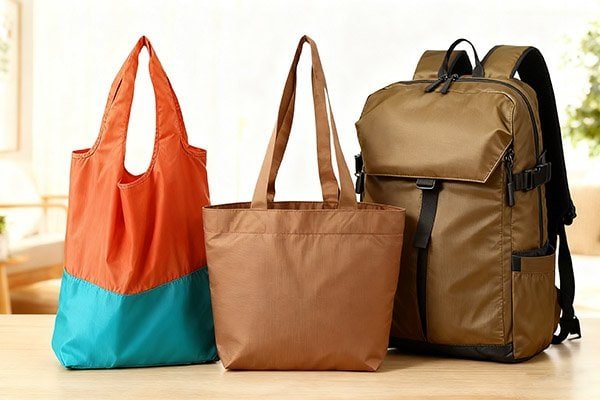
The different levels exist for a reason. Each thickness is best for a certain type of use. Knowing the common standards helps you talk to your supplier. It helps you get the exact bag you want. You do not want a heavy fabric when you needed a light one.
Detailed Breakdown of Standard Deniers
The choice of Denier defines the bag’s performance standard. For ultra-light promotional items, you might use 190T/210D. This is an economical choice. The bag is simple to produce and very light to ship. Moving up to 300D offers a noticeable jump in quality. This medium-weight fabric is often used for high-quality gift bags or school totes. It provides better tear resistance and a more substantial feel, which increases the valeur perçue of the gift. The 420D range is a great intermediate. It is used for gym bags or casual backpacks where you need strength but also some flexibility. Finally, the 600D fabric is the standard for durability. This material is thick, often coated for water resistance, and highly resistant to scratching. It is ideal for luggage, computer bags, or any bag that will face rough treatment. By understanding these tiers, you can align your product quality with your brand’s market position.
| Denier/Thread Count | Description | Primary Use (Example) | Key Feature |
|---|---|---|---|
| 190T–210D | Very thin, smooth, lightweight | Foldable shopping bags, simple drawstring pouches | Extreme portability |
| 210D–300D | Standard medium thickness | Daily use tote bags, small gym bags, trade show giveaways | Cost-effective durability |
| 420D | Durable, good structure, moderate weight | Backpacks, camera bag interiors, equipment covers | Strength with some flexibility |
| 600D | Heavy-duty, rigid structure, rugged feel | Travel duffel bags, laptop bags, cooler bag exteriors | Maximum resistance and load capacity |
How Does Thickness Affect Printing and Customization?
You have a beautiful logo. You need it to look perfect on the bag. Does the fabric thickness change how your logo looks?
Yes, fabric thickness affects printing quality. Thicker polyester fabrics usually have a smoother surface. This is better for screen printing and heat transfers. Too-thin fabric wrinkles easily. This can distort your logo. Choosing the right thickness ensures your design looks sharp and professional.
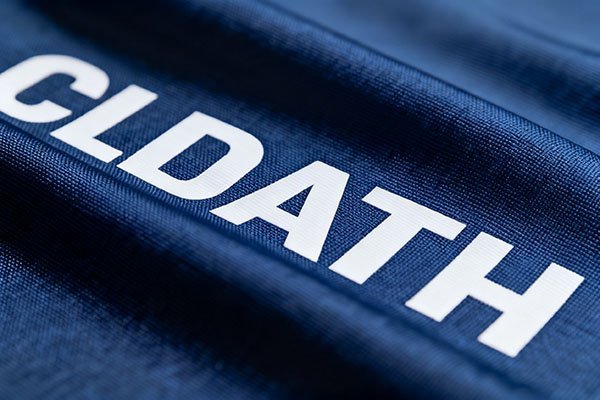
Le print is the face of your brand. You must ensure the bag fabric is a good canvas. A thin fabric can cause issues. The ink might bleed. The thinness can show marks from the printing press. A slightly thicker, more stable fabric gives a better result. You get a clean, crisp logo every time.
Fabric Stability and Detail Resolution
The stability of the fabric during printing is vital for a high-resolution image. Thin fabrics, especially those around 190T, can easily shift or stretch slightly during the screen printing process. This slight movement can cause the logo’s lines to look blurry, or the colors to not line up perfectly. Thicker fabrics, like 300D or higher, are more stable on the printing table. They do not shift. This stability is key for detailed logos or multi-color prints. Furthermore, a thicker fabric helps hide the texture of the weave. This allows the print to appear solid and vibrant. If your logo has fine text or small, intricate details, choosing a medium-to-thick fabric ensures the details are visible and sharp after the ink is applied and dried.
Compatibility with Advanced Printing Methods
Not all printing methods work equally well on all thicknesses. For simple, light bags (190T/210D), silk screen printing is the most common and cost-effective choice. However, for a high-end, photo-quality logo, you might consider dye sublimation ou heat transfer. These methods require the fabric to withstand high heat and pressure. Thicker, more stable polyester, such as 600D with a PU coating, handles this heat and pressure much better. The coating prevents the heat from warping the fabric. Very thin fabric can show marks from the heat press. You must discuss your logo’s detail level with your supplier. They can advise on the minimum thickness needed for your chosen printing technique.
| Printing Method | Best Thickness Range | Key Consideration |
|---|---|---|
| Sérigraphie | 210D–600D | Need smooth, stable surface for clean lines |
| Heat Transfer / Sublimation | 300D–600D | Must be able to withstand heat and pressure without damage |
| Digital Printing (DTG) | Not common on Polyester, but needs very stable surface | Avoid very thin fabrics that wrinkle easily |
How to Choose the Best Polyester Fabric for Your Custom Bag Project?
You have all the facts now. You need a final plan. What are the core steps to make the best choice for your brand’s bag?
You choose the best fabric by looking at four things. First, consider the bag’s main purpose. Second, decide how durable it needs to be. Third, think about your logo’s printing needs. Finally, check your budget. Always ask for fabric samples to feel the thickness before you decide.
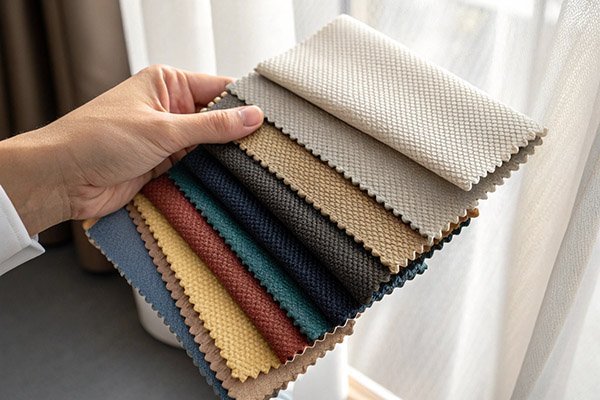
Making the right choice for your custom bag is simple. You must align the thickness with the use. You do not want to over-spend on a 600D bag for a light item. You also do not want a 190T bag to carry heavy books. A smart choice leads to a high-quality, long-lasting product. This is the key to good brand promotion.
Adopting Sustainable and Practical Decisions
The best choice balances cost-effectiveness avec la durabilité et function. Polyester is already a cost-effective option. You can make it an eco-friendly choice by specifying rPET (recycled polyester). rPET is made from recycled plastic bottles. This is a big win for the environment. rPET fabric is just as durable as virgin polyester. For a brand that values sustainability, this material choice is very strong. The thickness selection must then complement the rPET choice. A medium weight 300D rPET is often the ideal compromise. It is durable enough to promote your brand for a long time. It clearly communicates your commitment to the planet. This integrated thinking, combining rPET material with the right Denier, is the key to a successful custom bag project.
The Importance of Hands-On Sampling
Reading numbers is not enough. You must feel the fabric. The hand-feel of the fabric directly impacts the customer’s perception of your brand’s quality. A 190T fabric feels very flimsy. A 600D fabric feels substantial and rugged. Before you place a large order, you should ask your supplier for samples of different Denier weights. This allows you to check the texture, the stiffness, and the actual weight. You can also test how a sample logo looks on the actual fabric thickness. This simple step of comparing samples can save your business from costly mistakes. Rely on the supplier’s expertise to guide you toward the best option that matches your vision and budget.
| Core Principle | Key Action for Success | Why It Matters |
|---|---|---|
| Function First | Clearly define the heaviest load the bag will carry | Ensures the bag does not fail early, protecting your brand image |
| Value Assessment | Compare cost between 210D, 300D, and 600D | Finds the perfect balance between quality feel and budget |
| Material Upgrade | Request rPET (Recycled Polyester) options | Makes a strong statement about your brand’s environmental values |
| Final Check | Always request and examine physical fabric samples | Confirms the texture and print quality before mass production |
Conclusion
Choosing polyester thickness is easy when you match the Denier to the bag’s purpose. This ensures durability, good printing, and a high-value feel for your brand.
Frequenty Asked Questions
Q: Does a waterproof coating change the Denier or GSM of a polyester bag?
A: A waterproof coating, like PU or PVC, does not change the base Denier (D) of the fabric yarn. However, the coating adds material weight, so it will significantly increase the overall GSM (Grams per Square Meter) of the final fabric.
Q: Is rPET (recycled polyester) fabric as strong and durable as virgin polyester at the same Denier?
A: Yes. Modern manufacturing processes ensure that rPET fiber maintains a strength and durability profile that is nearly identical to virgin polyester when produced at the same Denier count. It offers the same performance with a better environmental impact.
Q: What is "190T" polyester, and why is it measured by T (Thread Count) instead of Denier (D)?
A : 190T (or 210T) is a very lightweight, thin polyester typically used for linings or ultra-foldable bags. It is often measured by Thread Count (T) because its primary selling point is its thin, silk-like quality rather than its heavy-duty yarn strength, which is the focus of Denier.
Q: Does a thicker polyester bag (e.g., 600D) take longer to dry than a thin one (e.g., 210D)?
A: Yes, a thicker bag takes longer to dry. This is because the denser weave and thicker fibers of 600D absorb and retain more moisture than a lightweight, thin fabric. Coatings on the thick fabric can slow drying further.
Q: Can I combine two different Denier polyester fabrics on the same custom bag?
A: Yes, this is a common design strategy. Brands often use a high Denier (e.g., 600D) for the main body and bottom panels for durability, and a lower Denier (e.g., 210D) for the interior lining or side pockets to reduce overall weight and cost.
Q: How does thickness affect the cost difference between screen printing and heat transfer on polyester bags?
A: Thickness mainly affects the printing cost by influencing the fabric stability. Thicker fabrics are easier to stabilize for both methods, leading to less production waste. The printing method itself, not the thickness, is the main cost driver.
Q: For a high-visibility safety bag, does fabric thickness affect the brightness of the color?
A: No, the fabric thickness (Denier) does not directly control color brightness. Color vibrancy depends on the dye quality and the color of the yarn. However, a thicker weave can make the color appear more solid and opaque.
Q: If a bag has a reinforcement at the handle, can I use a thinner Denier for the body?
A: Yes. Reinforcing high-stress areas like the handles or bottom with strong stitching or extra material allows you to choose a lower Denier (e.g., 210D) for the bag’s main body, significantly reducing material costs without fully compromising carrying strength.
Q: Is there a maximum weight limit for a 600D polyester bag?
A: While 600D is very strong, the maximum load capacity is determined more by the stitching quality (thread type, stitch pattern) and the handle strength than by the fabric Denier alone. A well-made 600D tote can typically handle 25–40 pounds safely.
Q: How do I prevent a thin polyester bag (e.g., 210D) from wrinkling when stored?
A: To minimize wrinkling in thin polyester, store the bag by folding it neatly into a small square or rolling it tightly. Do not crush or stuff it randomly. Thicker bags are naturally more wrinkle-resistant and do not require this careful storage.

